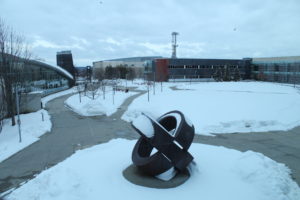Snow closures affect students and staff alike
Julio Rodriguez
Editor-in-Chief

The two nor’easters which hit campus on March 7 and 14 resulted in college closures. How did these closures become a reality?
“The college’s Vice President for Administration and Finance [,William Reuter,] consults with the Physical Plant director [Richard Edwards] and Public Safety staff before recommending action to the president,” said Assistant Director of Communications and Marketing Eric Bryant. “Ultimately, the president has the final say on the college’s action, but he takes into consideration the recommendations of his staff.”
College administrators begin discussing inclement weather and its impact on the college as soon as impending inclement weather reports begin flooding screens.
Since the start of the semester, the college has closed or postponed classes on four separate occasions. The closures began on Wednesday Feb. 7 when the college closed, effective noon.
One of the more recent closures on March 7 left some students confused about the exact reason for the campus closing down.
“I thought the closings were well placed until the next day [March 8],” said Mortuary Science student Tiffany Krausse. “[The weather] was a bit worse, and the college didn’t close.”
Many student commute from Syracuse and Massachusetts, and the nature of the program attracts students from various locations because of the lack of mortuary science programs in the area, Krausse said.
“I think they should have closed because it was dangerous getting here,” Krausse said. “There are a lot of people who are from Syracuse in my major that drive all the way out here, and the roads have been bad for them as well. It’s gotten to the point where our professor will tell us, ‘If the roads are dangerous, don’t come in.’”
When determining whether there will be a closure, there are a number of steps the college takes to reach a final decision.
“The college considers local weather forecasts and road conditions, the ability to clear college parking lots and pedestrian paths,” Bryant explained. “It consults with local transportation and law enforcement authorities as well.”
Individual Studies student Morgan Trotta has missed class time because of the closures.
“I’ve missed a lot of class time for one of my classes, so that’s put us really far behind,” Trotta said. “We’re kind of rushing through everything. It hasn’t affected my work because I haven’t been able to get the work with school being closed. It’s affecting
how I feel about the class. I’m not feeling as stable as I did before.”
Trotta said the first two closures were warranted. She does not believe the recent closures on March 7 and 14 should have resulted in a college closure.
“They probably expected it to be worse, but it wasn’t,” Trotta said. “The first few were definitely needed because the snow was bad. When they only closed campus after 12 p.m., I thought that was a little weird, and I missed my class again.”
Bryant explained that the loss of classroom time is a reality when campus officials are tasked with ensuring the safety of students commuting to campus.
“It’s not an exact science,” Bryant stated. “We have to weigh the safety of our students with the potential loss of classroom time. Sometimes, the weather doesn’t cooperate with our decision making, but we have student safety as our highest priority.”
In terms of financing, the college does budget an amount for snow removal, but the amount of snow sometimes exceeds projected budget allocations for the year, Bryant said.
“It’s all based on how severe the winter weather has been, thus the need for plowing, salting and other associated maintenance,” Bryant said.
